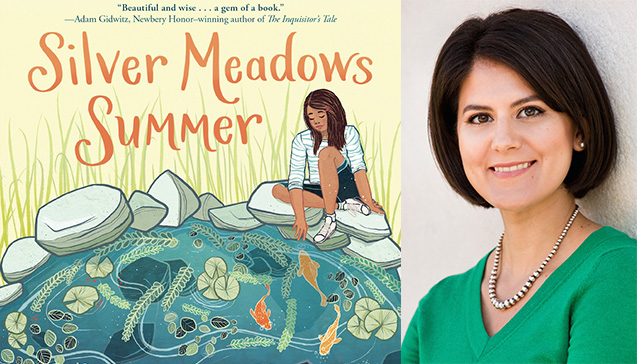There is No Path: A Guest Post from Silver Meadows Summer Author Emma Otheguy

In middle school, I studied Robert Frost’s poem “The Road Not Taken.” We learned about dilemmas and discussed whether Frost’s poem was about making tough choices, about following your heart, or about striking out on your own, despite the possibility of greener or easier pastures. Personally, I loved the poem for reasons separate from its thematic meaning: I was fascinated by the image of a yellow wood, of leaves no steps had trodden black. Growing up just outside of New York City, I don’t think I had ever seen that kind of yellow wood, except maybe its urban and suburban cousins—the bike path to City Island in autumn, the footpaths kids walking to school naturally cleared between houses. But I had visited such a wood in my imagination; the poem spoke to me of the sort of secret place that Anne and Diana might find tucked away somewhere on Prince Edward Island, the sort of place I always wanted to find.
Debug Notice: No product response from API
At home, I was taught a different poem about paths and choices. My parents, Cuban exiles and proud New Yorkers, were fond of an album by Catalan musician Joan Manuel Serrat. One of the songs drew its lyrics from a poem by Spanish poet Antonio Machado that says, “Caminante, no hay camino, se hace camino al andar”—Traveler, there is no path, you make your path by walking. The poem continues, “Caminante, no hay camino, sino estelas en la mar”—Traveler, there is no path, only your wake upon the sea.
At home, I was taught a different poem about paths and choices. My parents, Cuban exiles and proud New Yorkers, were fond of an album by Catalan musician Joan Manuel Serrat. One of the songs drew its lyrics from a poem by Spanish poet Antonio Machado that says, “Caminante, no hay camino, se hace camino al andar”—Traveler, there is no path, you make your path by walking. The poem continues, “Caminante, no hay camino, sino estelas en la mar”—Traveler, there is no path, only your wake upon the sea.
It was unsurprising to my young self that my parents’ choices-and-paths poem would have the sea instead of the woods; anything that sticks to them involves the sea. I had never seen a yellow wood, but I had seen the wake a ship leaves in the water many times. Every summer, we would go to Puerto Rico, where my father’s family was living. My cousins closest in age to me had a boat, and I got to see firsthand the tracks it would leave, frothing white, then smooth, and fading. This was the only sort of path Frost’s Spanish contemporary Machado would admit; one that was temporary, made by movement and not by planning.
I found a real road in a yellow wood eventually, years later while driving down a back road in the Hudson Valley. It was like returning to a place I had visited before, like going to Cuba for the first time: being somewhere at once both intimately known and wholly new. The woods were full of places hidden and forgotten, the sort of places that Anne and Diana had found, places that belonged in Enright novels, or to England, to Mandy and to Mary Lennox. I thought about what it was to be a Cuban removed from the tropics, to be in a place with an abundance of cleared trails but no obvious path to the type of Latina I would be. My grandmothers were dying, and I didn’t know how I would relate to my family without their connection. I didn’t know how I would relate to the natural world if I returned to the city. I didn’t even know where to begin, except to follow that craving for an inner life, the one that had led me to devour children’s books about secret hideouts and locked-away havens. I started writing Silver Meadows Summer, and I gave my eleven-year-old Cuban and Puerto Rican protagonist Carolina the freedom to move forward without a path, to choose what marks she wanted to leave.
Carolina’s family moves from Puerto Rico to the Hudson Valley, from urban to rural and tropical to temperate. She finds an abandoned little house in the woods, where she sketches the flamboyán trees of the Caribbean and makes her first new friend since her move. I gave Carolina the kind of secret hideout I loved from my childhood reading without sacrificing the magic of the Caribbean: Carolina fights to keep the Cucarachita Martina and the Ratoncito Pérez, two beloved characters from Caribbean folklore. She builds an idea of her own Latinidad as she gets to know her cousins, the way I did each summer in Puerto Rico. She brings her Caribbean identity to bear on the yellow wood around her. “Traveler, there is no path,” said my parents and Antonio Machado, “only your wake upon the sea”—wherever you are, in the clear waters of the Caribbean and in the tangled paths of the Hudson Valley.
Silver Meadows Summer hits B&N bookshelves on April 30th, 2019.